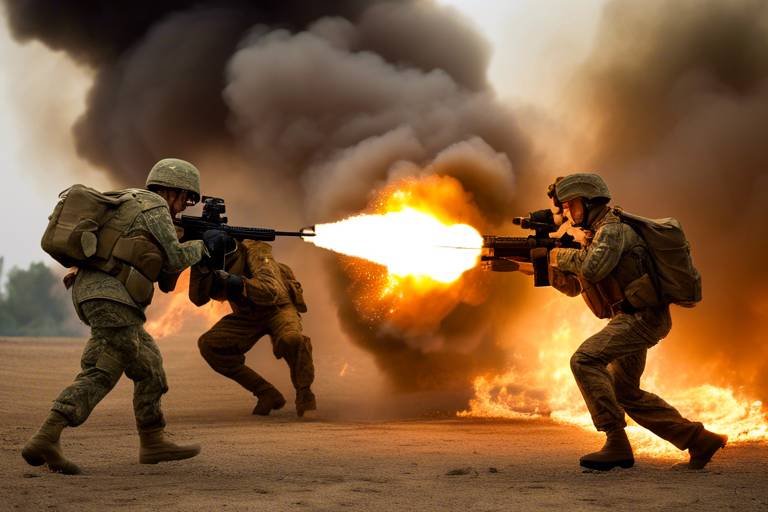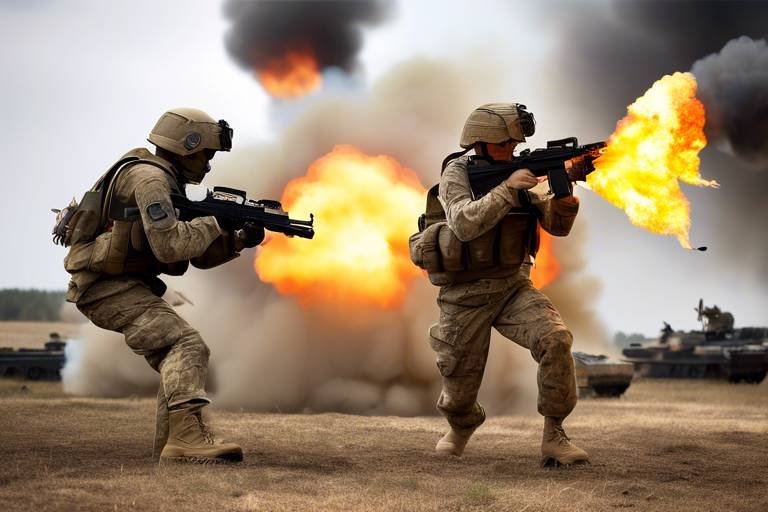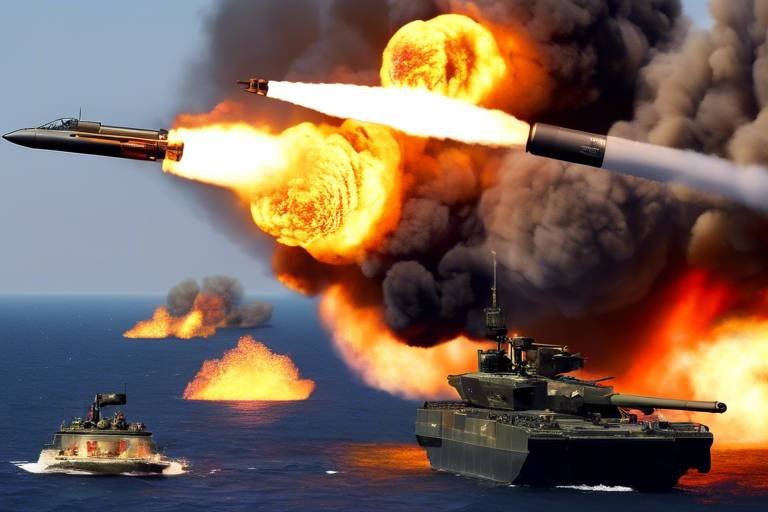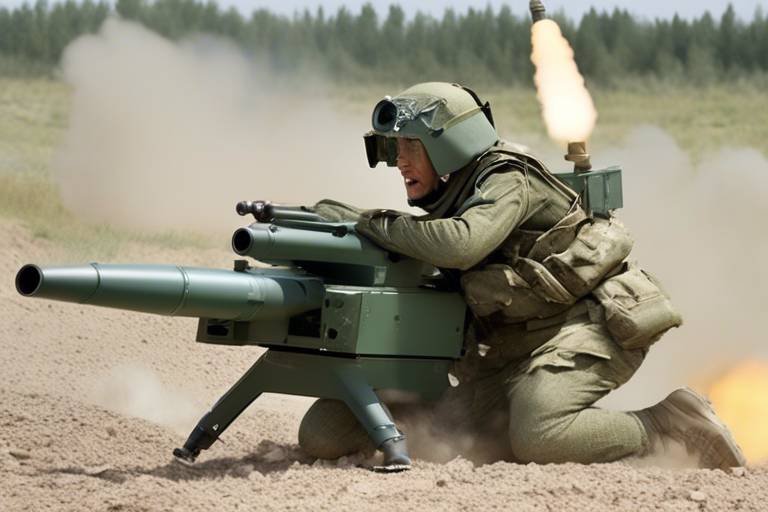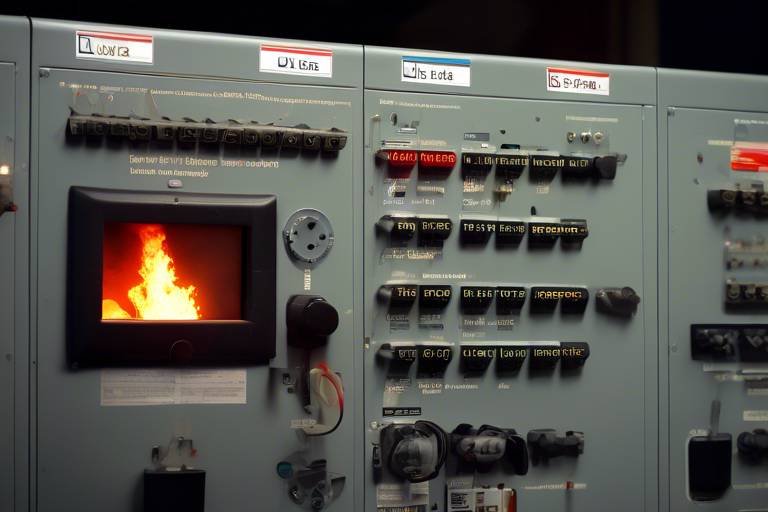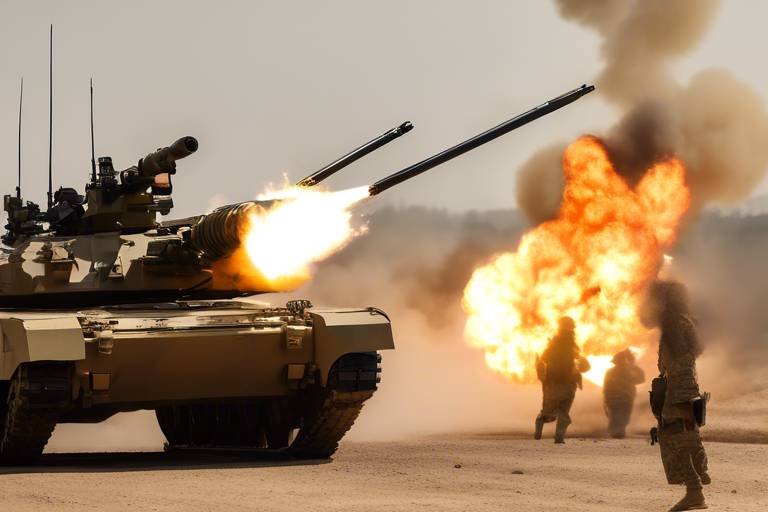The Role of Simulation Training in Firepower Operations
In the ever-evolving landscape of military and defense operations, simulation training has emerged as a game-changer, particularly in the realm of firepower operations. Imagine being able to hone your skills in a safe and controlled environment without the inherent risks of live-fire exercises. This innovative approach not only enhances the effectiveness of training but also ensures that personnel are well-prepared to face the complexities of real-world scenarios. With the integration of advanced technologies, simulation training is revolutionizing how military forces approach readiness and operational efficiency.
One of the most compelling aspects of simulation training is its ability to replicate high-stress environments. Think about it: when soldiers are placed in a simulated combat zone, they can practice their decision-making and tactical skills under pressure, all without the fear of actual danger. This method allows for a deeper understanding of firepower operations, as trainees can make mistakes and learn from them without dire consequences. The result? A more adept and confident force ready to tackle any challenge that may arise on the battlefield.
Moreover, simulation training is not just about individual skill development; it also fosters team cohesion. In a military context, effective communication and coordination among team members are crucial. Through simulated exercises, teams can work together, refine their strategies, and build trust, all essential components for success in real-life operations. The blend of technology and teamwork creates a dynamic training environment that prepares personnel for the complexities of modern warfare.
As we delve deeper into the benefits and technologies behind simulation training, it becomes evident that this approach is not merely a trend but a necessary evolution in military training. From cost-effectiveness to risk reduction, the advantages are profound and far-reaching. In the following sections, we will explore these benefits in detail, examine the various types of simulation technologies, and understand how they contribute to enhancing firepower operations.
Simulation training offers numerous advantages, including:
- Cost-effectiveness: Reduces the need for expensive live-fire exercises and ammunition.
- Risk reduction: Minimizes the potential for accidents and injuries during training.
- Realistic practice: Allows personnel to engage in high-stress scenarios without real-world consequences.
These benefits make simulation training an essential component of modern military education, ensuring that personnel are not only prepared but also confident in their abilities.
Various simulation technologies are utilized in firepower training, including:
- Virtual Reality (VR): Immerses trainees in realistic scenarios, enhancing their understanding of firepower operations.
- Augmented Reality (AR): Overlays digital information onto the real world, providing real-time tactical insights.
- Computer-based Simulations: Offers a range of scenarios for practice and evaluation.
Each of these technologies provides unique experiences that enhance learning and operational readiness, making them invaluable tools in the training arsenal.
1. What is simulation training?
Simulation training is a method of training that uses technology to replicate real-world scenarios, allowing personnel to practice their skills without the risks associated with live exercises.
2. How does simulation training improve safety?
By providing a controlled environment for training, simulation reduces the likelihood of accidents and injuries, allowing personnel to learn and practice safely.
3. Can simulation training replace live training?
While simulation training offers many benefits, it is most effective when combined with live training exercises, providing a comprehensive approach to skill development.
4. What technologies are used in simulation training?
Technologies such as virtual reality, augmented reality, and computer-based simulations are commonly used to create immersive training experiences.
5. How does simulation training enhance teamwork?
Simulation training allows teams to practice together, improving communication, coordination, and trust among team members, which are critical for success in real-life operations.
Benefits of Simulation Training
Simulation training is revolutionizing the way military and defense personnel prepare for firepower operations. One of the most significant advantages of this innovative approach is its cost-effectiveness. Traditional training methods often require expensive resources, such as live ammunition, specialized equipment, and extensive logistical support. In contrast, simulation training allows for a more economical use of resources, enabling organizations to allocate funds towards other crucial areas while still providing high-quality training experiences.
Another critical benefit is the risk reduction it offers. In a field where mistakes can have dire consequences, simulation training provides a safe environment for personnel to practice their skills. By replicating high-stress scenarios without the inherent dangers of live operations, trainees can learn from their errors without risking injury or loss of life. This aspect is particularly important for developing decision-making and tactical skills, as individuals can experiment with different strategies and approaches without facing real-world repercussions.
Moreover, simulation training allows for the replication of high-pressure environments, which is essential for effective learning. The ability to simulate various combat situations means trainees can experience the adrenaline and stress of real operations. This immersion helps them to develop the mental fortitude necessary to make quick, informed decisions under pressure. For instance, consider how an athlete practices under game-like conditions; the same principle applies to military training. By simulating the chaos of a battlefield, personnel can hone their skills in a way that is both realistic and beneficial.
Additionally, simulation training enhances team dynamics and communication skills. In the heat of battle, effective coordination among team members can mean the difference between success and failure. Through simulated exercises, individuals learn to communicate clearly and work together seamlessly. This not only improves their operational readiness but also fosters a sense of camaraderie and trust among team members, which is vital in high-stakes situations.
In conclusion, the benefits of simulation training are manifold, ranging from cost savings and risk reduction to improved decision-making and teamwork. As military and defense organizations continue to embrace this innovative approach, they will undoubtedly see enhanced efficiency and effectiveness in their firepower operations.
Types of Simulation Technologies
In the realm of firepower training, simulation technologies play a crucial role in shaping the effectiveness and readiness of military personnel. These technologies are not just fancy gadgets; they are the backbone of modern training methodologies, allowing for a more immersive and engaging learning experience. The three primary types of simulation technologies that are making waves in this field include Virtual Reality (VR), Augmented Reality (AR), and Computer-Based Simulations. Each of these technologies brings its own unique flavor to training, enhancing the overall learning experience.
Virtual Reality is perhaps the most talked-about technology in simulation training. It transports trainees into a fully immersive digital environment where they can engage in realistic scenarios. Imagine being able to practice firing a weapon or executing tactical maneuvers without ever leaving the safety of a training facility. VR provides this opportunity, allowing personnel to face the complexities of firepower operations in a controlled setting. The sensory experiences in VR—sights, sounds, and even haptic feedback—help develop critical muscle memory for real-life situations.
On the other hand, Augmented Reality takes a different approach by overlaying digital information onto the real world. This technology allows trainees to receive real-time data and tactical insights during their training exercises. For instance, as a soldier looks through their weapon's sights, AR can display critical information like target distance, wind speed, and even enemy movements. This integration of digital elements enhances situational awareness, making it easier for personnel to make informed decisions under pressure.
Lastly, we have Computer-Based Simulations, which serve as a versatile platform for training. These simulations can range from simple tactical scenarios to complex operational exercises that require strategic thinking and teamwork. They often include scenario-based training, where trainees can engage in various missions that mimic real-world challenges. The beauty of computer-based simulations lies in their ability to be tailored to specific training needs, allowing for a focused approach to skill development.
| Technology Type | Description | Benefits |
|---|---|---|
| Virtual Reality (VR) | Immerses trainees in a fully digital environment. | Enhances muscle memory, provides realistic scenarios. |
| Augmented Reality (AR) | Overlays digital data onto the real world. | Improves situational awareness and decision-making. |
| Computer-Based Simulations | Offers a range of tactical and operational scenarios. | Flexible training tailored to specific needs. |
In summary, the integration of these simulation technologies not only enhances training efficiency but also significantly improves the safety and effectiveness of firepower operations. As the military continues to evolve, embracing these innovations will be key to maintaining a competitive edge on the battlefield.
- What is the main advantage of using simulation technologies in firepower training?
Simulation technologies allow for a safe environment where personnel can practice and refine their skills without the risks associated with live training. - How does virtual reality enhance learning in firepower operations?
VR immerses trainees in realistic scenarios, allowing them to experience the complexities of firepower operations and develop critical muscle memory. - What role does augmented reality play in training?
AR provides real-time data and tactical insights, improving situational awareness and decision-making during training exercises.
Virtual Reality in Firepower Training
Virtual reality (VR) has revolutionized the way firepower training is conducted, creating a dynamic and immersive environment where trainees can engage in realistic simulations. Imagine stepping into a world where the chaos of battle feels palpable, yet you’re safe within the confines of a training facility. This is the power of VR—it allows military personnel to experience the complexities of firepower operations without the inherent risks of live training exercises.
One of the most compelling aspects of VR in firepower training is its ability to replicate high-stress scenarios that soldiers might face in actual combat. For instance, trainees can find themselves in a virtual battlefield where they must make split-second decisions under pressure. This not only enhances their tactical skills but also helps in developing muscle memory for critical tasks. The realism created by high-fidelity graphics and sophisticated physics engines ensures that every action feels authentic, making the learning experience both engaging and effective.
Moreover, the immersive nature of VR training significantly boosts retention rates. Studies have shown that individuals are more likely to remember information and skills learned in an engaging environment. In a VR setting, trainees can repeat scenarios multiple times, refining their techniques and strategies until they feel confident. This level of practice is akin to a musician rehearsing a piece; the more they play, the better they become. In this way, VR serves as a powerful tool for skill acquisition and retention.
Another fascinating feature of VR technology is its adaptability. Training programs can be tailored to meet the specific needs of different units or missions. For example, a unit preparing for urban warfare can engage in simulations that mimic the complexities of city combat, complete with virtual obstacles and civilian interactions. This customization ensures that the training is relevant and directly applicable to the challenges they will face in the field.
To illustrate the impact of VR in firepower training, consider the following table that highlights key benefits:
| Benefit | Description |
|---|---|
| Realistic Scenarios | Trains personnel in environments that closely mimic actual combat situations. |
| Enhanced Decision-Making | Allows for practice in high-pressure situations, improving quick thinking and tactical choices. |
| Muscle Memory Development | Facilitates repetitive practice of critical tasks, leading to improved performance in real scenarios. |
| Customizable Training | Enables the creation of specific scenarios tailored to the needs of different units or missions. |
In conclusion, virtual reality is not just a trend in firepower training; it’s an essential tool that enhances the preparedness of military personnel. By immersing trainees in realistic scenarios, VR fosters a learning environment that is both effective and engaging. As technology continues to advance, the potential for VR to transform firepower operations training will only grow, paving the way for a new era of military readiness.
- What is virtual reality training? Virtual reality training uses immersive technology to simulate real-world scenarios for educational and training purposes.
- How does VR improve training outcomes? VR enhances training by providing realistic environments, improving decision-making skills, and allowing for repetitive practice without real-world risks.
- Can VR training be customized? Yes, VR training can be tailored to meet the specific needs of different military units or missions, ensuring relevant and effective training experiences.
- Are there any risks associated with VR training? While VR training is generally safe, users may experience motion sickness or disorientation in some cases. Proper acclimatization and training protocols can help mitigate these effects.
Realism in VR Simulations
When it comes to training for firepower operations, realism is key. Virtual reality (VR) simulations are designed to create environments that mimic real-life scenarios with stunning accuracy. Imagine stepping into a world where every detail, from the sound of gunfire to the feel of the terrain beneath your feet, is crafted to replicate actual conditions. This level of realism not only enhances the training experience but also prepares personnel for the unexpected.
The immersive nature of VR allows trainees to engage in dynamic situations that would be impossible to replicate in traditional training settings. For instance, they can face various challenges such as unpredictable weather conditions, changing enemy tactics, or even the chaos of a battlefield. By experiencing these scenarios in a controlled environment, trainees develop a deeper understanding of operational complexities and learn to react instinctively. This is akin to a pilot using a flight simulator to practice emergency procedures before ever taking to the skies; it builds confidence and competence.
Moreover, the high-fidelity graphics and realistic physics engines used in VR simulations contribute significantly to the overall training effectiveness. These technologies ensure that the movements and interactions within the simulation are not just visually appealing but also physically accurate. For example, when a soldier fires a weapon in a VR environment, the recoil and trajectory of the projectile are modeled to reflect real-world physics. This attention to detail allows trainees to develop muscle memory for critical tasks, making their responses second nature when faced with real-life challenges.
In addition to just visual realism, VR simulations also incorporate auditory elements that enhance the training experience. The sounds of gunfire, the roar of vehicles, and the chatter of teammates are all part of the immersive environment. These auditory cues help trainees develop their situational awareness, making them more adept at interpreting sounds and making decisions under pressure. Just like a musician practices with a metronome to perfect timing, military personnel can hone their skills in a VR setting where every detail matters.
Ultimately, the realism in VR simulations fosters a safe learning environment where mistakes can be made without dire consequences. This allows trainees to explore various strategies, learn from their errors, and refine their skills. It’s a bit like a rehearsal before a big performance; the more familiar you are with your role and the environment, the better you perform when it truly counts. With VR, the stakes are high, but the risks are mitigated, allowing for a more enriching and effective training experience.
- What is the main advantage of using VR in military training?
VR provides a realistic training environment that enhances decision-making skills and muscle memory without the risks associated with live training. - How does VR improve situational awareness?
By immersing trainees in realistic scenarios with auditory and visual cues, VR helps them learn to interpret information quickly and accurately. - Can VR simulations replace live training exercises?
While VR is an excellent supplement to live training, it is most effective when integrated with actual exercises to reinforce learning.
Benefits of Immersive Learning
Immersive learning, particularly through the use of Virtual Reality (VR), has revolutionized the way military personnel are trained in firepower operations. Imagine stepping into a training environment where the sights, sounds, and even the physical sensations of real combat are simulated to perfection. This level of immersion not only captivates the trainees but also significantly enhances their learning experience. One of the primary benefits is the increased retention of information. Studies have shown that when individuals engage in immersive environments, they are more likely to remember the skills and tactics they practiced. This is akin to learning to ride a bike; the more you practice, the more instinctual it becomes.
Furthermore, immersive learning allows for a safe space where mistakes can be made without dire consequences. In traditional training scenarios, the fear of failure can hinder performance. However, in a virtual setting, personnel can experiment with different strategies and tactics, learning from their errors in real-time. This trial-and-error approach fosters a deeper understanding of complex firepower operations and encourages critical thinking. It's like playing a video game where you can restart the level after making a mistake, but in this case, the stakes are much higher, and the lessons are invaluable.
Another significant advantage of immersive learning is the ability to replicate high-stress environments. In real combat situations, decisions must be made swiftly and under pressure. VR simulations can mimic these conditions, allowing trainees to practice their decision-making skills in a controlled yet realistic setting. This exposure prepares them mentally and emotionally for the challenges they will face in the field. As they navigate through these scenarios, they develop muscle memory and a sense of familiarity with their weapons and tactics, which can be crucial in high-pressure situations.
Moreover, immersive learning promotes teamwork and communication among trainees. Many VR training programs are designed for group participation, where individuals must work together to achieve common objectives. This aspect not only enhances their tactical skills but also builds camaraderie and trust within the team. By experiencing the highs and lows of simulated missions together, they learn to rely on one another, creating a stronger and more cohesive unit. In essence, immersive learning is not just about individual skill enhancement; it’s about fostering a collective spirit that is essential for successful firepower operations.
In conclusion, the benefits of immersive learning are multifaceted. From improved information retention and safe experimentation to high-stress decision-making and enhanced teamwork, this innovative training approach is transforming how military personnel prepare for real-world challenges. As we continue to integrate advanced technologies into training regimens, the potential for even greater learning outcomes becomes limitless.
- What is immersive learning? Immersive learning refers to training methods that engage participants in realistic environments, often using technologies like Virtual Reality (VR) and Augmented Reality (AR).
- How does VR enhance firepower training? VR immerses trainees in realistic combat scenarios, allowing them to practice skills and decision-making in a safe and controlled environment.
- Can immersive learning improve teamwork? Yes, immersive learning often involves group activities that enhance communication and collaboration among team members.
- What are the risks of traditional training methods? Traditional methods can lead to real-world consequences in training mistakes, whereas immersive learning allows for safe experimentation.
Augmented Reality Applications
Augmented reality (AR) is revolutionizing the way military personnel train for firepower operations. By seamlessly integrating digital elements into the real world, AR offers a unique training experience that enhances learning and operational readiness. Imagine donning a pair of smart glasses that not only display critical data but also overlay tactical visuals right onto the battlefield. This technology allows soldiers to access real-time information, making their training not just informative but also incredibly engaging.
One of the most significant advantages of AR in firepower training is its ability to provide real-time data and tactical insights. For instance, during a training exercise, a soldier could receive instant feedback on their performance, including information about their positioning, weapon accuracy, and even the status of their teammates. This immediate feedback loop is invaluable, as it allows trainees to adjust their strategies on the fly, mirroring the dynamic nature of actual combat scenarios.
Moreover, AR applications can simulate various environmental conditions, giving trainees the chance to practice under different scenarios without the associated risks. From urban warfare to open-field engagements, AR can transform any location into a realistic training ground. This versatility is crucial for preparing soldiers for the unpredictable nature of real-life operations.
Consider the following key features of AR applications in firepower training:
- Enhanced Situational Awareness: AR provides soldiers with a comprehensive view of their surroundings, helping them make informed decisions quickly.
- Improved Tactical Training: By visualizing enemy positions and potential threats, trainees can develop more effective strategies.
- Collaborative Learning: AR facilitates teamwork, allowing multiple trainees to interact with the same digital overlays, fostering communication and coordination.
In summary, augmented reality applications are not just a technological advancement; they represent a paradigm shift in how military training is conducted. By merging the digital and physical worlds, AR enriches the training experience, ensuring that personnel are better prepared for the challenges they will face in the field. As this technology continues to evolve, we can expect even more innovative applications that will further enhance the effectiveness of firepower operations.
- What is augmented reality? Augmented reality is a technology that overlays digital information onto the real world, enhancing the user's perception of their environment.
- How does AR improve military training? AR improves military training by providing real-time data, enhancing situational awareness, and allowing for collaborative learning in realistic scenarios.
- Can AR be used in live training exercises? Yes, AR can be integrated into live training exercises to provide instant feedback and tactical insights, improving overall effectiveness.
Integrating Simulation with Live Training
When it comes to military training, the stakes are incredibly high. Lives depend on the skills and decisions made during operations. This is where the integration of simulation training with live exercises becomes a game-changer. By combining these two training methodologies, military personnel can hone their skills in a way that is not only effective but also safe. Imagine being able to practice high-pressure scenarios without the risk of real-world consequences. That's the beauty of integrating simulations with live training.
One of the most significant advantages of this integration is the ability to apply simulated skills in real-world scenarios. Trainees can first immerse themselves in virtual environments where they can learn and practice tactics. Once they feel confident, they can transition to live exercises, where the stakes are much higher. This method ensures that lessons learned in the virtual world are reinforced in a real-world context, creating a seamless learning experience.
Furthermore, integrating simulation with live training enhances coordination and communication among team members. In a combat situation, every second counts, and clear communication can be the difference between success and failure. By practicing together in simulated environments, teams can develop a shared understanding of tactics and strategies. This shared experience translates into better performance during live exercises, as everyone is aligned and knows their roles. The synergy created through this integration fosters a culture of teamwork that is essential in high-stakes environments.
Moreover, simulation training provides valuable feedback and analytics that can be utilized to evaluate performance. After a live exercise, trainers can assess how well individuals and teams performed by comparing their actions against the data collected during simulations. This feedback loop is crucial for identifying areas for improvement. For instance, if a team struggles with a particular tactic during a live exercise, trainers can return to the simulation environment to focus on that specific skill set. This iterative process ensures that training is always evolving and adapting to the needs of the personnel.
In summary, the integration of simulation training with live exercises creates a comprehensive training regimen that enhances operational readiness. By allowing personnel to practice in both virtual and real-world environments, military organizations can ensure that their teams are not only skilled but also adaptable to the unpredictable nature of combat scenarios. This innovative approach to training is paving the way for more effective and safer military operations.
- What is the main advantage of integrating simulation with live training?
Integrating simulation with live training allows personnel to practice skills in a safe environment before applying them in real-world scenarios, enhancing their readiness and effectiveness. - How does simulation training improve communication among team members?
Simulation training fosters teamwork and a shared understanding of tactics, which translates into better communication during live exercises. - Can simulation training be tailored to specific missions?
Yes, simulation training can be customized to replicate specific mission scenarios, allowing teams to prepare for unique challenges they may face.
Enhancing Coordination and Communication
In the realm of firepower operations, coordination and communication are not just buzzwords; they are the lifeblood of successful missions. When military personnel engage in simulations, they are not merely practicing skills; they are immersing themselves in a dynamic environment that mirrors the complexities of real-world scenarios. This immersive experience fosters a deeper understanding of how to work as a cohesive unit, making it essential for effective teamwork.
Simulation training creates a platform where teams can practice their communication strategies in a risk-free environment. Imagine a group of soldiers preparing for a mission. In a simulation, they can experiment with different communication methods and observe the outcomes without the pressure of real-life consequences. This approach helps them identify the most effective ways to convey critical information, ensuring that everyone is on the same page when it matters most.
Moreover, the integration of simulation training with live exercises amplifies the benefits of enhanced coordination. By combining both methods, personnel can transition smoothly from virtual scenarios to real-world applications. This seamless integration helps to reinforce the lessons learned during simulations, allowing teams to build upon their experiences and continuously improve their strategies.
One of the standout features of simulation training is the ability to analyze performance in real-time. During these exercises, trainers can monitor how well teams communicate and coordinate their actions. This data can then be used to provide targeted feedback, pinpointing areas that require improvement. For instance, if a team struggles with passing critical information during a simulated crisis, trainers can step in to offer guidance and strategies for better communication.
Furthermore, simulation training encourages personnel to engage in active listening and develop a keen awareness of their teammates' actions and reactions. This heightened sense of awareness is crucial in high-stakes environments where split-second decisions can mean the difference between success and failure. By practicing these skills in simulations, teams can cultivate a culture of trust and collaboration, which is vital for operational success.
To illustrate the importance of coordination and communication, let’s consider a simple table that highlights the differences between traditional training and simulation-based training:
| Aspect | Traditional Training | Simulation Training |
|---|---|---|
| Risk Level | High | Low |
| Feedback Availability | Delayed | Immediate |
| Realism | Limited | High |
| Team Dynamics | Less Focused | Enhances Dynamics |
As you can see, simulation training not only reduces risk but also provides immediate feedback and enhances team dynamics, making it a more effective method for developing coordination and communication skills. Ultimately, the goal is to ensure that every member of the team can operate seamlessly together, especially when the pressure is on. With the right training, they can face any challenge with confidence and clarity.
- What is simulation training? Simulation training involves the use of technology to replicate real-world scenarios for training purposes, allowing personnel to practice skills in a controlled environment.
- How does simulation training improve communication? It allows teams to practice communication strategies in a risk-free setting, enabling them to identify the most effective methods for conveying critical information.
- Can simulation training be integrated with live exercises? Yes, combining simulation training with live exercises creates a comprehensive training regimen that reinforces lessons learned and enhances operational readiness.
- What technologies are used in simulation training? Technologies such as virtual reality (VR), augmented reality (AR), and computer-based simulations are commonly used to create immersive training experiences.
Evaluating Performance Through Simulations
In the realm of military training, evaluating performance through simulations has become a cornerstone for developing effective personnel. The beauty of simulation training lies not just in the practice of skills, but in the ability to assess and refine those skills in a controlled environment. This is where the magic happens: trainers can observe how individuals and teams react under pressure, allowing them to provide targeted feedback that can significantly enhance performance.
One of the key benefits of simulation-based evaluations is the immediate feedback mechanism. Unlike traditional training methods where feedback may come days or weeks later, simulations can provide real-time analytics. This allows trainees to make adjustments on the fly, fostering a learning environment that is both dynamic and responsive. For example, if a trainee struggles with a particular tactical maneuver, the simulation can be paused to discuss the issue, allowing for a deeper understanding of the tactical principles at play.
Moreover, performance evaluation tools integrated within simulations can track various metrics, such as reaction times, decision-making accuracy, and teamwork efficiency. These metrics can then be compiled into comprehensive reports that highlight strengths and weaknesses. Consider the following table that illustrates some common performance metrics evaluated during simulation training:
| Metric | Description | Importance |
|---|---|---|
| Reaction Time | Time taken to respond to a stimulus | Critical for quick decision-making in the field |
| Accuracy of Decisions | Correctness of tactical choices made during the simulation | Ensures strategic effectiveness in real operations |
| Team Coordination | How well team members work together | Essential for mission success |
Additionally, simulations can mimic the chaos of actual combat scenarios, providing invaluable insights into how individuals cope with stress and uncertainty. Trainers can analyze how well trainees maintain focus and adhere to protocols when faced with unexpected challenges. This aspect of training is crucial, as it prepares personnel not only to execute tasks but also to adapt and improvise when things don’t go according to plan.
Finally, the evaluative aspect of simulation training extends beyond individual performance. It also encompasses team dynamics. By observing how teams communicate and coordinate during simulations, trainers can identify gaps in teamwork and collaboration. This insight allows for targeted interventions, fostering a more cohesive unit that operates effectively under pressure.
In conclusion, evaluating performance through simulations is a multifaceted process that combines immediate feedback, comprehensive metrics, and real-world scenarios. This innovative approach not only enhances individual skill sets but also strengthens team cohesion, ultimately leading to improved operational readiness.
- What types of metrics are used in performance evaluations? Metrics can include reaction time, accuracy of decisions, and team coordination.
- How does immediate feedback benefit trainees? It allows for on-the-spot corrections and adjustments, enhancing learning outcomes.
- Can simulations replicate real-world stress? Yes, simulations are designed to mimic the chaos and unpredictability of actual combat scenarios.
- Is team performance evaluated in simulations? Absolutely, team dynamics and communication are critical components of simulation training evaluations.
Frequently Asked Questions
- What is simulation training in firepower operations?
Simulation training in firepower operations involves using advanced technologies to create realistic training scenarios for military personnel. This approach allows trainees to practice their skills in a safe environment, enhancing their decision-making and tactical abilities without the risks associated with real-life operations.
- What are the benefits of using simulation training?
Simulation training offers numerous benefits, including:
- Cost-effectiveness by reducing the need for expensive live training exercises.
- Risk reduction, as trainees can practice high-stakes scenarios without real-world consequences.
- The ability to replicate high-stress environments, helping personnel develop critical skills under pressure.
- What types of simulation technologies are used?
There are several types of simulation technologies utilized in firepower training, including:
- Virtual Reality (VR): Provides immersive experiences, allowing trainees to engage in realistic scenarios.
- Augmented Reality (AR): Overlays digital information onto the real world, enhancing situational awareness.
- Computer-based simulations: Offers interactive training modules that can be tailored to specific needs.
- How does virtual reality enhance firepower training?
Virtual reality enhances firepower training by immersing trainees in realistic scenarios that mimic real-life challenges. This immersion helps develop muscle memory for critical tasks, improves retention of firepower tactics, and allows for repeated practice in a controlled environment.
- Can simulation training be integrated with live training exercises?
Absolutely! Integrating simulation training with live exercises creates a comprehensive training regimen. This combination allows personnel to apply the skills learned in simulations to real-world scenarios, reinforcing lessons and improving overall operational readiness.
- How is performance evaluated in simulation training?
Simulation training includes performance evaluation tools that provide detailed feedback and analytics. These tools help trainers assess individual and team effectiveness, identify areas for improvement, and ensure that personnel are meeting training objectives.






